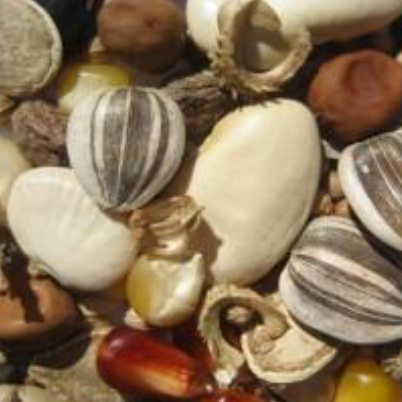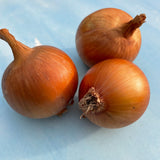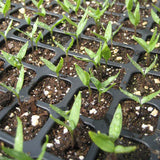
Seed's Eye View
 Planning for Seed Saving: Part one in our new Seed Saving series.
Planning for Seed Saving: Part one in our new Seed Saving series.
Seed saving used to be an integral part of many farms and gardens. Saving seeds was as practiced and assumed as harvesting a ripe tomato. Over time, as the landscape of seeds has changed from the intimate to the industrial, growers became so used to purchasing seed that we began to lose both the diversity of varieties as well as the skills needed save seeds at home.
It has not gotten more difficult to save seeds over the last 10,000 years, just less common. You don’t need a degree to save a seed. All the practice requires is some curiosity, observation, and a desire to become a better gardener.
This series will follow the Seed Library farm through the seasons from a seed’s perspective. Follow along at home: try your hand at seed saving and participate in an age-old tradition with a modern imperative.
Seed’s Eye View #1: Planning for Seed Saving
As gardeners, we’re used to interrupting our plants at their most delicious or beautiful moments. A flower just before its peak that’s perfect for picking. Cherry tomatoes hanging heavy all too ready to pop in your mouth. But these moments occur before the plant’s full life-cycle has played out. What would your carrot do if you never pulled it up out of the ground?
Before you even transplant your first seedling, you can start thinking about seed saving. Here are some things to consider while you’re planning your garden. I’ve broken this down into advice for beginning, intermediate, and advanced gardeners not because any of this is hard to do, but to make sure you don’t get overwhelmed. If you’ve never saved seeds before but want to jump in, you can try anything we cover in the Seed’s Eye View series. Just get seedy!
Beginners:
If you’ve never tried saving seeds or are feeling like you don’t know where to begin, the best place to start is with your plants. Let them go. By that I mean let them grow. Choose a few plants that you will let live their entire life cycle. It may take some self-discipline not to harvest a lettuce head before it bolts, but by letting it go you will gain a better understanding of the plant, experience the joy of nurturing it through its full life, and get to see what it needs to do to produce seed. You may not get a ton of seed, or any at all, but your first part of your seed collection is collecting plant knowledge.
 Recommendations for beginners:
Recommendations for beginners:
Here are a few annual varieties that can produce healthy, viable seed for you the first year you try.
Bush Beans: These cross-pollinate less than pole beans. Try Dragon’s Tongue or Provider Green Bean. Eat a whole bunch of them and let a few pods dry on the bush. When they are crisp shell them and you have beans to plant next year!
Peas: Laxton’s Progress is a delicious shell pea. Again, eat to your heart’s content, but leave some pods to dry on the vine.
Flower: Calendula make some of the coolest seeds ever- and easiest to save. Let your flowers fade on the plant. You’ll be able to see the green spiral seeds developing. Wait as long as you can until they are dry on the seed head but before they fall off. Grab the seed head and gently rub the seeds off into the palm of your hand.
 Herb: Cilantro is a two for one deal. When your cilantro bolts, let it go. It will grow tall, flower, attract beneficial insects to you garden, and then form jade green beads. These will turn brown and dry on the plant. Harvest them and you’ve got coriander for spice and seeds to plant in the fall.
Herb: Cilantro is a two for one deal. When your cilantro bolts, let it go. It will grow tall, flower, attract beneficial insects to you garden, and then form jade green beads. These will turn brown and dry on the plant. Harvest them and you’ve got coriander for spice and seeds to plant in the fall.
Tomatoes: Isis Candy Shop is our colorful gene pool of sweet cherry tomatoes. Some are orange, some red, some round, some oblong, and many marbled. Choose your favorites by taste or beauty. This is how heirlooms developed over time. Save seeds from these. (Look for a later post on how to save tomato seeds.)
Flower: Balloon Vine is an ornamental vine that is also called Heart Seed for good reason. Even the Latin is heart seeds- Cardiospenum because each seed has a small white heart imprinted on it. Wait for the lantern like pods to turn from chartreuse to rusty orange. Pick them and open them up. You’ll find three heart seeds in each pod.
Intermediate:
Seed saving is about a balance of intimacy and isolation. There is closeness between the bees and the plants that we all secretly envy. When you become a seed saver you become the bee. Once you start saving seeds, you will need to get more familiar with pollination. Since you are working with heirloom and open-pollinated varieties, they can cross pollinate. Your sweet peppers can cross with hot peppers and take on some heat the next year. Your butternut squash can cross with your cheese pumpkin: and it might not be that tasty!
For intermediate seed savers we recommend growing single varieties and using distance isolation. If you can grow just one cucumber variety, you don’t have to worry about it crossing with anything else.
In general as you become more intimate with your plants, you will also be giving them some space. Spacing your plants a bit wider than usual accomplishes two things. First, it gives the plant more nutrients. Lettuce for food can be grown densely, but lettuce for seed is another story. The plant can get up to 16 inches wide at the base and 3-4 feet tall. It’s a longer season from seed to flower to seed. So it needs more food. The second advantage of spacing is what is called distance isolation. Instead of growing all of your tomatoes in one mixed patch, intersperse a row of tomatoes with a few rows of something else. That way, you can be pretty sure that your tomato varieties won’t cross.
 Recommendations for Intermediate Gardeners:
Recommendations for Intermediate Gardeners:
Romaine lettuce: Spotted Trout. Plant as you normally would. Harvest every other plant to eat. That will be good spacing for the rest to get fully mature. (Look for a later post on how to save lettuce seeds.)
Parsnips: Easy to try as your first biennial. Plant and harvest based on our growing instructions. Mulch the bed in fall and let the roots overwinter. They will come back the next spring and you’ll be amazed by the bushy plant and large flowering umbels--a real showstopper in the garden.
Broccoli: One of the few annual brassicas. Beautiful when it flowers. Seeds are in pods. We’ll be doing a post all about Piracicaba Broccoli soon.
Watermelon: It’s best to grow just one variety. For northeast gardeners we recommend Sugar Baby or Blacktail Mountain. Grow as you normally would. Harvest when ripe. Eat, enjoy, and invest in a spittoon. That’s about all it takes!
For Advanced Gardeners:
If you want to grow many varieties and don’t have a ton of room, then your efforts will require a bit more proficiency. Isolation techniques such as hand-pollinating, caging, and timing can be tricky and require planning. Well-seasoned growers can experiment with these techniques as well as with growing biennials, which need to be overwintered to produce seed. Some varieties that we will be covering more in-depth in the coming months include Dino Kale, Benning’s Green Tint Patty Pan Squash, and King of the North Pepper.
More: Upcoming posts for everyone, including advanced seed savers, will cover: Step By Step Instructions, Isolation Techniques, Seed Harvesting and Cleaning by Plant Family, Seed Storage, Germination Testing, and Viability. Please feel free to post questions about each post in the comments. I'll do my best to answer them all. Stay seedy!






